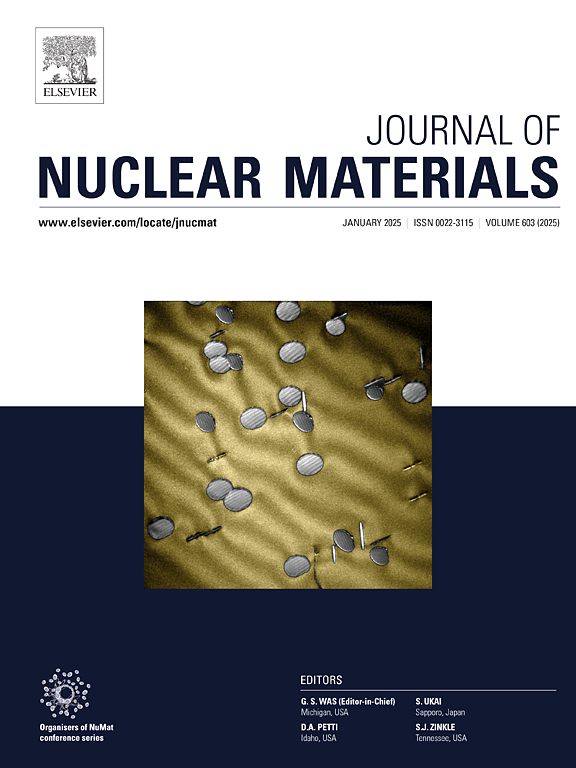探索铝合金中Mg2Si和富si相辐照缺陷的差异
IF 2.8
2区 工程技术
Q3 MATERIALS SCIENCE, MULTIDISCIPLINARY
引用次数: 0
摘要
析出相界面作为强缺陷汇,与辐照缺陷相互作用,影响材料的微观结构。在嬗变作用下,铝合金在核体系中不断形成Mg2Si和富si的析出相。然而,这些沉淀对辐照诱导的自间隙原子(SIAs)和空位的反应机制以及界面的作用仍然没有得到充分的阐明。本文采用原位透射电镜研究了Mg2Si和Si相制备的5xxx系铝合金在400 keV Al +和30 keV He +室温523-603 K辐照下SIAs和空位的演变。在相同的辐照损伤和He注入下,Mg2Si和富si析出相附近的缺陷演化有显著差异。与Si相不同,Mg2Si相在其表面和周围区域表现出优先的位错环形核和聚集。应变场和取向关系导致的SIAs和空位行为的差异导致了两种析出相环演化的差异。退火后,与富si相相比,Mg2Si相对释放的空位有更强的吸收,导致析出相内气泡呈明显的多面生长。这是由于它们的界面性质和空位迁移率不同。本文章由计算机程序翻译,如有差异,请以英文原文为准。

Exploring differences in irradiation-induced defects between Mg2Si and Si-rich precipitates in Al-alloys
The interfaces of precipitates serve as strong defect sinks that interact with irradiation defects, affecting the microstructure of materials. Under transmutation effects, Al-alloys in nuclear systems continuously form Mg2Si and Si-rich precipitates. Yet, the mechanisms by which these precipitates respond to irradiation-induced self-interstitial atoms (SIAs) and vacancies, as well as the role of interfaces, remain insufficiently elucidated. In this work, the evolution of SIAs and vacancies in a 5xxx-series Al-alloys, pre-prepared with Mg2Si and Si precipitates, was investigated through in-situ transmission electron microscopy during 400 keV Al⁺ and 30 keV He⁺ irradiation at room temperature and 523–603 K. Significant differences in defect evolution near Mg2Si and Si-rich precipitates were observed under similar irradiation damage and He implantation. Unlike the Si precipitates, the Mg2Si precipitates exhibited preferential nucleation and aggregation of dislocation loops on their surfaces and in surrounding regions. The differences in the behavior of SIAs and vacancies induced by the strain field and orientation relationships contributed to the variations in loop evolution for the two precipitates. After annealing, in contrast to Si-rich precipitates, Mg2Si precipitates exhibited a stronger absorption of released vacancies, leading to pronounced faceted growth of bubbles within the precipitates. This is attributed to differences in their interfacial properties and vacancy mobility.
求助全文
通过发布文献求助,成功后即可免费获取论文全文。
去求助
来源期刊

Journal of Nuclear Materials
工程技术-材料科学:综合
CiteScore
5.70
自引率
25.80%
发文量
601
审稿时长
63 days
期刊介绍:
The Journal of Nuclear Materials publishes high quality papers in materials research for nuclear applications, primarily fission reactors, fusion reactors, and similar environments including radiation areas of charged particle accelerators. Both original research and critical review papers covering experimental, theoretical, and computational aspects of either fundamental or applied nature are welcome.
The breadth of the field is such that a wide range of processes and properties in the field of materials science and engineering is of interest to the readership, spanning atom-scale processes, microstructures, thermodynamics, mechanical properties, physical properties, and corrosion, for example.
Topics covered by JNM
Fission reactor materials, including fuels, cladding, core structures, pressure vessels, coolant interactions with materials, moderator and control components, fission product behavior.
Materials aspects of the entire fuel cycle.
Materials aspects of the actinides and their compounds.
Performance of nuclear waste materials; materials aspects of the immobilization of wastes.
Fusion reactor materials, including first walls, blankets, insulators and magnets.
Neutron and charged particle radiation effects in materials, including defects, transmutations, microstructures, phase changes and macroscopic properties.
Interaction of plasmas, ion beams, electron beams and electromagnetic radiation with materials relevant to nuclear systems.
 求助内容:
求助内容: 应助结果提醒方式:
应助结果提醒方式:


